Sweet Corn IPM Newsletter No. 7- August 13, 2021
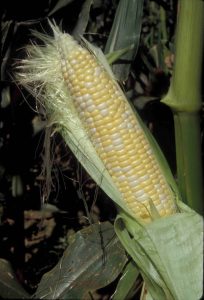
Sweet Corn IPM Newsletter No. 7- August 13, 2021
Click on photos to enlarge.
PEST NUMBERS REMAIN LOW
Fall Armyworm & Western Bean Cutworm Highest Threat to Silking Corn
SITUATION
Corn development has sped up rapidly with the onset of another spell of very warm weather this week. Harvest is in full swing and later plantings are developing swiftly. Pest activity remains very low in most locations. Corn earworm activity is especially low, and most fields are seeing the greatest threat from fall armyworm and western bean cutworm. The tropical front moving in late next week may bring in higher pest pressure.
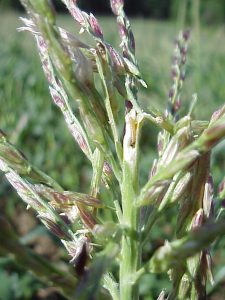
European corn borer:
No fields were over the 15% control threshold for feeding activity this week. European corn borer moth trap counts were over the silking spray threshold of 5/week at sites in Dayton and Monmouth.
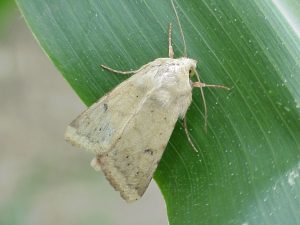
Corn earworm:
Pheromone trap moth captures were very low throughout the state; only four sites had recommended spray schedules for silking corn. A 4-day spray schedule was recommended for one site in Wells, a 5-day spray schedule was recommended in Lewiston and New Gloucester, and a 6-day spray schedule was recommended in Garland. No other sites required control of corn earworm at this time.
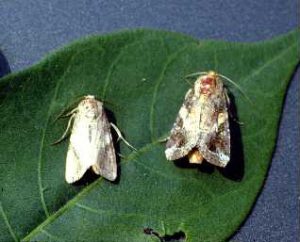
Fall armyworm:
Moths counts continue to be fairly low for this time in the season. Six sites were over the threshold of 3 moths per week in silking corn. Sprays to protect silking corn were recommended at: Auburn, Biddeford, Farmington, New Gloucester, one Dayton site and one Wells site. The New Gloucester site should be protected with the spray schedule recommended for corn earworm. No feeding damage has been found in the fields, but we expect to see it soon.
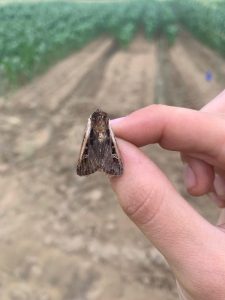
Western Bean Cutworm:
Moths continue to be widespread, but numbers have retreated from last week, ranging from 0 to 18. We have not yet seen feeding damage from larvae, but we are recommending that silking corn be protected if sprays are not already being applied to control corn earworm and/or fall armyworm.

Squash vine borer:
No traps were over the control threshold of 5 moths per week.
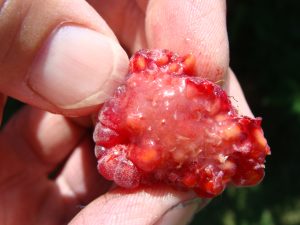
Spotted wing drosophila:
The number of flies caught in traps has increased significantly in raspberry and blueberry fields this week, raising the threat level to any ripening berries. A 7-day spray interval for fields with ripe raspberries, blackberries and blueberries is recommended. For more information visit our website

Powdery Mildew:
Weather conditions have been very conducive to the development of powdery mildew on pumpkins and squash. Be on the lookout for symptoms on plants and be ready to protect fields with a registered fungicide.
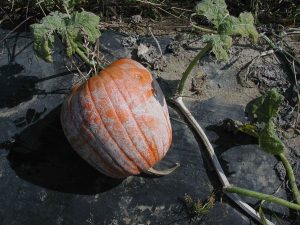
Plectosporium blight:
Plectosporium has been found in a pumpkin field this week. This fungus disease causes white flecking in the surface of the fruit and leaves, leading to collapse of the plants and fruit rot. See the New England Vegetable Management Guide for details. The fungicides Quadris®, Maneb®, Bravo®, Cabrio® and Flint® are registered to control Plectosporium.
Sincerely,
David T. Handley
Vegetable and Small Fruit Specialist
Highmoor Farm Pest Management Unit
P.O. Box 179 17 Godfrey Drive
52 U.S. Route 202 Orono, ME 04473
Monmouth, ME 04259
207.933.2100 1.800.287.0279
| Location | CEW
Moths |
ECB
Moths |
FAW
Moths |
%Feeding
Damage |
Recommendations / Comments |
|---|---|---|---|---|---|
| Auburn | 0 | 0 | 4 | 0% | One spray for FAW on silking corn |
| Biddeford | 0 | 0 | 5 | 4% | One spray for FAW on silking corn |
| Bowdoinham | 1 | 0 | 0 | 0% | No spray recommended |
| Cape Elizabeth | 0 | 1 | 1 | 0% | No spray recommended |
| Dayton I | 0 | 5 | 0 | 0% | One spray for ECB on silking corn |
| Dayton II | 0 | 0 | 3 | 0% | One spray for FAW on silking corn |
| Farmington | 0 | 0 | 3 | 0% | One spray for FAW on silking corn |
| Garland | 2 | 0 | 1 | 2% | 6-day spray interval for silking corn |
| Lewiston | 4 | 0 | 0 | 0% | 5-day spray interval for silking corn |
| Monmouth | 0 | 23 | 0 | 1% | One spray for ECB on silking corn |
| New Gloucester | 4 | 0 | 18 | 0% | 5-day spray interval for silking corn |
| Oxford | 0 | 0 | 2 | 8% | No spray recommended |
| Palmyra | 1 | 0 | 0 | 1% | No spray recommended |
| Sabattus | 1 | 3 | 0 | 0% | No spray recommended |
| Wayne | 1 | 0 | 0 | 0% | No spray recommended |
| Wells I | 0 | 0 | 5 | 4% | One spray for FAW on silking corn |
| Wells II | 9 | 4 | 0 | 3% | 4-day spray interval for silking corn |
CEW: Corn earworm (Only fresh silking corn should be sprayed for this insect.)
ECB: European corn borer
FAW: Fall armyworm
| Moths caught per week | Moths caught per night | Spray interval |
|---|---|---|
| 0.0 to 1.4 | 0.0 to 0.2 | No spray |
| 1.5 to 3.5 | 0.3 to 0.5 | Spray every 6 days |
| 3.6 to 7.0 | 0.6 to 1.0 | Spray every 5 days |
| 7.1 to 91 | 1.1 to 13.0 | Spray every 4 days |
| More than 91 | More than 13 | Spray every 3 days |
Thresholds apply only to corn with exposed fresh silk. Lengthen spray intervals by one day if maximum daily temperature is less than 80°F.
European Corn Borer Thresholds
Whorl stage: 30% or more of plants scouted show injury.
Pre-tassel-silk: 15% or more of plants scouted show injury.
Silk: 5 or more moths caught in pheromone traps in one week.
IPM Web Pages:
Where brand names or company names are used, it is for the reader’s information. No endorsement is implied nor is any discrimination intended against other products with similar ingredients. Always consult product labels for rates, application instructions and safety precautions. Users of these products assume all associated risks.
The University of Maine is an equal opportunity/affirmative action institution.
